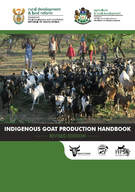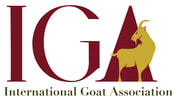|
Authors: David Pugh N. (Nickie) Baird Misty Edmondson and Thomas Passler Description Get practical answers from the only guide on the care of sheep, goats, and cervids! Authoritative yet easy to read, Sheep, Goat and Cervid Medicine, 3rd Edition covers all the latest advances in the field, including diseases and medical treatment, surgery, pain management, theriogenology, and nutrition. Clear instructions and hundreds of full-color photographs guide you step by step through common procedures including restraint for examination, administration of drugs, blood collection, and grooming. New to this edition is coverage of deer and elk medicine, reflecting the growing interest in these ruminants. Written by an expert team led by Dr. D.G. Pugh, this comprehensive reference is ideal for veterinarians and also for owners of sheep and goats. Key Features
Table of Contents
Appendix II: Practical Fluid Therapy Appendix III: Normal Values and Conversions
3 Comments
 Edited by Sándor Kukovics Széchenyi István University of Sciences Goat science covers quite a wide range and varieties of topics, from genetics and breeding, via nutrition, production systems, reproduction, milk and meat production, animal health and parasitism, etc., up to the effects of goat products on human health. In this book, several parts of them are presented within 18 different chapters. Molecular genetics and genetic improvement of goats are the new approaches of goat development. Several factors affect the passage rate of digesta in goats, but for diet properties, goats are similar to other ruminants. Iodine deficiency in goats could be dangerous. Assisted reproduction techniques have similar importance in goats like in other ruminants. Milk and meat production traits of goats are almost equally important and have significant positive impacts on human health. Many factors affect the health of goats, heat stress being of increasing importance. Production systems could modify all of the abovementioned characteristics of goats. You can download each chapter at IntechOpen, https://www.intechopen.com/books/goat-science.  That Sheep May Safely Graze is written by David Sherman, former Editor-in-Chief of Small Ruminant Research, 2001-2005. Veterinarian and global goat health expert David Sherman shares his big-picture view of the development challenges in Afghanistan based on his years of living there. He illustrates the importance of animal health, often overlooked by development experts, so readers can appreciate how healthy sheep and goats provide livelihoods for rural people, food for hungry cities, and wool for beautiful carpets. The book contains numerous short and charming vignettes that vary from quiet delight in small farm life to portraits of fascinating individuals to frustration with ever-changing political agendas. Most importantly, David invites readers to see the dignity and humanity in his Afghan colleagues and ordinary villagers. Western development aid has resulted in too few successes, but this highly readable account of Afghanistan’s veterinary field unit project is a “how-to” of effective assistance that improves the lives of animals and the people who depend on them. Beth A. Miller President, International Goat Association This book will be released on March 15, 2019, but it is available to pre-order from Amazon in paperback or Kindle editions. A global view of small ruminant production gives a fascinating and truly global insight into the daily lives of vets, livestock keepers and the sheep and goats in their care. Featuring over 400 images and accompanying texts from over 50 countries, this collection was first displayed at the 9th International Sheep Veterinary Congress in Harrogate in 2017.
 To participate in this book, contact Prof. Sándor Kukovics, the Academic Editor at [email protected]. About the book There are several papers published about goats kept and bred around the world, but a breed inventory covering goat breeds on various continents (and countries) is missing. We propose to create this book. Goats (Capra) will be very useful for people interested in goats. Along with an inventory, there will be summarized information about why these goats were bred, their products, and what kinds of developments in targeting better meat, milk, hair, pelt, and skin production have been carried out until now.  download a copy download a copy Produced by: Mdukatshani, HPSA, Department of Rural Development and Land Reform (DRDLR) and KwaZulu-Natal Department of Agriculture and Rural Development (DARD) Special thanks to Marisia Geraci, IGA's Country Representative for South Africa for sharing this information. How to use this book The aim of this book is to assist owners of indigenous goats with extensive farming systems. It looks at ways to improve the productivity of their herds. It is designed to be shared with farmers in a way that allows them to understand how to find their way through the book and how to find the information that they need. It is best if the book is used as part of a capacity building programme being implemented by extension officers and field workers. There are further training materials to support training farmers with this book. They are available at www.mdukatshani.com, www.hpsa.org.za or www.gapkzn.co.za. These are training modules linked to sections in the book and can be downloaded as pdfs for printing, or as PowerPoint presentations. These training materials reference this book’s sections and pages. Welfare, Health and Breeding Editors: Simões, João, Gutiérrez, Carlos  About this book This book explores the current trends and challenges of sustainable goat meat and milk production in different global contexts, providing valuable insights into this industry in adverse environments like mountain, semiarid and arid regions. It also includes contributions from international experts discussing goat reproduction, genetic diversity and improvement, as well topics such as animal health, welfare, socioeconomic aspects, and many other issues regarding the environmentally friendly and economically viable exploitation of goats. This is a highly informative book providing scientific insight for readers with an interest in sustainable agriculture and socio-economic aspects, as well as goat breed conservation, genetic diversity, and veterinary care. These subjects are complemented in a second volume providing a detailed description of more than 40 indigenous goat breeds and several ecotypes found in Asia, Africa, Europe, and America.  Utilizando Buenas Prácticas Ganaderas Autor: Clara Viviana Rúa Bustamante, Miembro de IGA Investigador Master y Zootecnista, Coordinación de Innovación Regional, Corporación Colombiana de Investigación Agropecuaria (CORPOICA), Augustin Codazzzi, Cesar, Colombia PRESENTACIÓN La leche de cabra y derivados, se consideran una fuente de proteína animal de alta calidad nutricional, excelente alternativa para los programas de seguridad alimentaria y fuente de ingresos en sistemas de producción diversificados; es una especie que favorece la participación de mano de obra femenina; es una especie la cual, además de la leche, se puede realizer un buen aprovechamiento de productos y subproductos (piel, heces, visceras). La construcción del presente manual constituye un aporte para el desarrollo y mejoramiento de los sistemas de producción de leche de cabra en el departamento de Antioquia y en Colombia. La Secretaría de Agricultura y Desarrollo Rural de Antioquia, en su Plan de Desarrollo y su Programa de Fomento a la Producción Agropecuaria Sostenible; plantea el apoyo y promoción de prácticas responsables y amigables con el ambiente, apoyando proyectos que involucren los conceptos de Buenas Prácticas Agrícolas –BPA y Buenas Prácticas de Manufactura- BPM. Es así como se han venido realizando alianzas con entidades y profesionales independientes de gran experiencia en diferentes sistemas de producción agropecuarios, para el desarrollo de manuales de actualización tecnológica, en este caso de producción de leche de cabra utilizando Buenas Prácticas Ganaderas –BPG. Con este MANUAL TÉCNICO DE PRODUCCIÓN DE LECHE DE CABRA, UTILIZANDO BUENAS PRÁCTICAS GANADERAS, se pretende dar a conocer y difundir los aspectos básicos para la crianza de cabras lecheras. Se incluyen aspectos técnicos y prácticos que han demostrado ser eficaces bajo los diversos sistemas de producción del país. Diseñado para ser utilizado por capricultores que están o se inician en la actividad caprina, por estudiantes, técnicos y profesionales que deseen conocer y aprender sobre el tema. Descargue su copia  Description Global Cheesemaking Technology: Cheese Quality and Characteristics reviews cheesemaking practices, and describes cheeses and the processes from which they are manufactured. In addition, the book examines new areas to stimulate further research in addition to the already established knowledge on the scientific principles on cheesemaking. Part I provides an account on the history of cheese, factors influencing the physicochemical properties, flavour development and sensory characteristics, microbial ecology and cheese safety, traceability and authentication of cheeses with protected labels, and traditional wooden equipment used for cheesemaking, while an overview of the cheesemaking process is also presented. Part II describes 100 global cheeses from 17 countries, divided into 13 categories. The cheeses described are well-known types produced in large quantities worldwide, together with some important locally produced, in order to stimulate scientific interest in these cheese varieties. Each category is presented in a separate chapter with relevant research on each cheese and extensive referencing to facilitate further reading. Purpose of this book
The aim of this book is to assist owners of indigenous goats with extensive farming systems. It looks at ways to improve the productivity of their flocks. It is designed to be shared with farmers in a way that allows them to understand how to find their way through the book and how to find the information that they need. It is best if the book is part of a capacity building programme being implemented by extension officers and field workers. There are further training materials to support training farmers on this book. They are available at www.mdukatshani.com or www.heifer.org.za. These are training modules linked to sections in the book and are in downloadable .pdf for printing or a downloadable PowerPoint presentation. |
IGA Blog
The International Goat Association promotes goat research and development for the benefit of humankind, to alleviate poverty, to promote prosperity and to improve the quality of life. Archives
May 2024
Categories
All
|
|
International Goat Association
2516 Millbrook Rd., Little Rock, AR72227 USA email: [email protected] -454-1641 |

 RSS Feed
RSS Feed